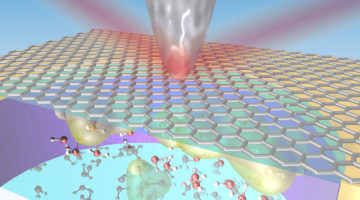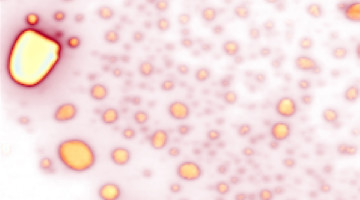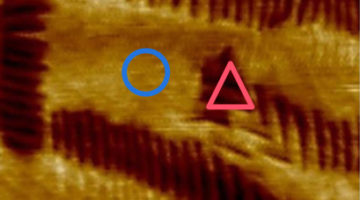Researchers developed a new infrared approach to probing the first few molecular layers of a liquid in contact with a graphene electrode under operating conditions. The work offers a new way to study the interfaces that are key to understanding batteries, corrosion, and other bio- and electrochemical phenomena. Read more »![]()
![]()
Controlling Spin in Antiferromagnetic Nanostructures
Researchers discovered that the spin configuration of a nanostructured antiferromagnetic material can be affected by the dimensions of features imprinted onto the material. The results suggest that nanoscale patterning can be a viable tool for engineering spin configurations in future antiferromagnetic spintronic devices. Read more »![]()
![]()
A Citizen-Science Computer Game for Protein Design
Using the computer game, “Foldit,” nonexpert citizen scientists designed new proteins whose structures, verified at the ALS, were equivalent in quality to and more structurally diverse than computer-generated designs. The work shows the potential of using crowd-based creativity in the design of new proteins for fighting illness and disease. Read more »![]()
![]()
Newly Discovered Minerals Reveal Anomalous Origins
Researchers characterized two highly unusual nickel-containing minerals, both unearthed in an ancient geological site in southern central Siberia. The findings extend our understanding of naturally occurring mineral species and varieties and provide useful insights into the environments leading to the formation of potentially valuable mineral ores. Read more »![]()
![]()
Renewed Prospects for Rechargeable Mg Batteries
Contrary to previous reports, it’s possible to create a rechargeable battery using magnesium ions if the electrode material is first conditioned at high temperature. With twice the charge of lithium ions, magnesium ions hold great promise as the basis for high-energy-density batteries suitable for use in electric vehicles. Read more »![]()
![]()
Tuning Material Properties with Laser Light
Researchers demonstrated that coupled electronic and magnetic properties in a material can be repeatably tuned using laser light. The results suggest the possibility of creating microelectronic devices that use a laser beam to erase and rewrite bits of information in materials engineered for random-access memory and data storage. Read more »![]()
![]()
How Light-Harvesting Bacteria Toggle Off and On
Researchers clarified the atomic-level mechanism that enables bacteria to switch light harvesting off and on in response to potentially damaging overexposure to light. The results could have long-range implications for artificial photosynthesis and optogenetics—the use of light to selectively activate biological processes. Read more »![]()
![]()
Linking Structure to Behavior in Twisted Liquid Crystals
Researchers untangled connections between structure and behavior in a class of liquid crystals consisting of flexible, chain-like molecules that self-organize into twisting patterns. The study opens up new possibilities for designing novel liquid-crystal molecules that allow greater control of nanoscale behavior for technological applications. Read more »![]()
![]()
Electric Dipoles Form Chiral Skyrmions
Researchers demonstrated that polar skyrmions—cousins of magnetic skyrmions but comprising swirls of electric dipoles instead of spins—exhibit chirality in a material with electrically switchable properties. Control of such phenomena could one day lead to low-power, nonvolatile data storage as well as to high-performance computers. Read more »![]()
![]()
Breakthrough in Membrane-Protein Design Settles Long-Standing Debate
Scientists characterized designed membrane proteins to better understand the forces that stabilize these large, complex structures. The results necessitate a rethinking of membrane-protein biophysics and could lead to better therapies for related illnesses as well as functional membrane proteins for engineering applications. Read more »![]()
![]()
- « Previous Page
- 1
- …
- 9
- 10
- 11
- 12
- 13
- Next Page »









